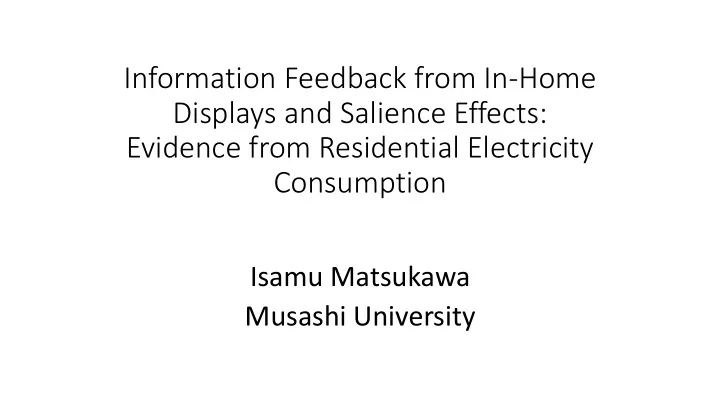

Information Feedback from In-Home Displays and Salience Effects: Evidence from Residential Electricity Consumption Isamu Matsukawa Musashi University
Overview • Motivation • Policy intervention: providing households with in-home displays (IHDs) • Randomized field experiment: IHD together with pecuniary incentives for electricity saving during peak hours • Results: effects of IHDs
Motivation • Inattention to consumption information: suboptimal consumption regardless of the individual’s information - processing capacity (DellaVigna, 2009) • Limited capacity to process information: mistakes in choosing optimal consumption even when fully informed (de Palma, Myers, and Papageorgiou, 1994) • Under these circumstances, deviations from full consumption optimization reduce consumer welfare, making policy interventions necessary to increase attention and information-processing capacity
Research Questions • Q1. Does the cumulative usage of IHDs affect residential electricity consumption? • Q2. Is IHD provision energy-saving? • Q3. Do pecuniary incentives affect electricity consumption and IHD usage?
Randomized Field Experiment • Summer: July 23, 2012, to September 13, 2012 (36 days) • Subjects: 501 households living in the south of Kyoto, Japan • Control : 126 households • Treatment : 375 households could use IHDs at any time during the experiment
Pecuniary Incentives for Peak Reduction • Money-convertible electronic points worth 70 US dollars (1 US dollar = 100 yen): 70% of the monthly average electricity expenditure • Treatment lost points which were computed as the product of the unit electricity price (40, 60, or 80 cents per kWh) and electricity consumption during peak hours on “ critical peak days ” • Households that saved more electricity during peak hours could receive more money by converting electronic points in the end • Five critical peak days for each price of electricity were called on a day-ahead basis • 20 cents during peak hours of non-critical peak days on weekdays
Location and Climate of the Experimental Site 35 ° C 33 31 29 Kansai Science City 27 25 23 21 19 17 Jun.12 Jul.12 Aug.12 Sep.12 Mean temperature Maximum temperature Minimum temperature Source: Japan Meteorological Agency. http://www.jma.go.jp. Source: Kansai Science City, http://www.keihanna-plaza.co.jp
Comparison between the Control and Treatment Groups before the Experiment Control Treatment Mean Mean Difference Daily-average electricity usage in 12.36 11.89 – 0.47 June 2012 (kWh/day) (7.35) (6.20) ( – 0.63) 0.36 0.28 – 0.08 All electric = 1 (0.48) (0.45) ( – 1.57) Notes: The column “Difference” indicates the difference in each variable for the treatment group with respect to the control group. In the column “Mean,” standard deviations are in parentheses. In the column “Difference,” t - statistics are in parentheses. Source: The Keihanna Eco-City Next-Generation Energy and Social Systems Demonstration Project Promotion Council
Average Hourly Electricity Consumption 0,900 kWh 0,850 Treatment Control 0,800 0,750 0,700 0,650 0,600 0,550 0,500 0,450 0,400 1 2 3 4 5 6 7 8 9 10 11 12 13 14 15 16 17 18 19 20 21 22 23 24 Hour Source: The Keihanna Eco-City Next-Generation Energy and Social Systems Demonstration Project Promotion Council
Proportion of Households Using IHDs by Hour of the Day 12,0% 10,0% 8,0% 6,0% 4,0% 2,0% Hour 0,0% 1 2 3 4 5 6 7 8 9 10 11 12 13 14 15 16 17 18 19 20 21 22 23 24 Source: The Keihanna Eco-City Next-Generation Energy and Social Systems Demonstration Project Promotion Council
Model for Electricity Consumption & IHD Use • log( KWH i,t ) = a i + [ b 0 + b 1 log( KWH_6 i ) ] log( 1 + S i,t -1 + δ i,t ) + ∑ k c k D k,i,t − ω 1,2 M i,t + ∑ k h k H k,t + ε 1,i,t • L i,t = α i + ∑ k τ k D k,i,t + ∑ k μ k H k,t + ε 2,i,t • KWH i,t : electricity consumption of household i at time t 𝑢 : dummy for IHD use, S i,t = σ 𝑙=1 𝜀 𝑗,𝑙 • δ i,t • L i,t : latent variable for IHD use, δ i,t = 1 if L i,t ≥ 0, and δ i,t = 0 if L i,t < 0 • D k,i,t : dummy for price k (k = 20, 40, 60, 80 cents/kWh) • H k,t : dummy for hour or date • KWH _6 i : household i ’s daily-average electricity consumption in June 2012 • ε 1,i,t , ε 2,i,t : error terms whose covariance is ω 1,2 • M i,t : inverse Mills ratio
Q1. Does the cumulative usage of IHDs affect residential electricity consumption? • YES, 1% significance of the coefficients of the term log 1 + 𝑇 𝑗,𝑢−1 + 𝜀 𝑗,𝑢 and the interaction term log(1 + S i,t -1 + δ i,t ) × log( KWH _6 i ) in the fixed effects model
Q2. Is IHD provision energy-saving? • YES, for households that consumed more than 15.55 kWh per day in June 2012 (approximately 20% of all households). • NO, for households that consumed less than 15.55 kWh per day in June 2012 (approximately 80% of all households) • Contrast with the previous literature that indicates energy- conservation effects of the presence of an IHD • Reason (1): analysis of information acquisition • Reason (2): “boomerang effect” of IHD use against excessive energy- saving after Fukushima
Q3. Do pecuniary incentives affect electricity consumption and IHD usage? • YES for both electricity consumption and IHD usage • Energy-saving effects of pecuniary incentives on peak- time consumption range from 13% to 24% • Pecuniary incentives encourage households to use IHDs
Conclusion • IHD use is expected to reduce deviations from the optimal consumption by salience and learning through attention • While the cumulative usage of IHDs reduced the electricity consumption of “energy - using” households, it raised that of “energy - saving” households whose electricity consumption had been relatively modest before the experiment
Recommend
More recommend